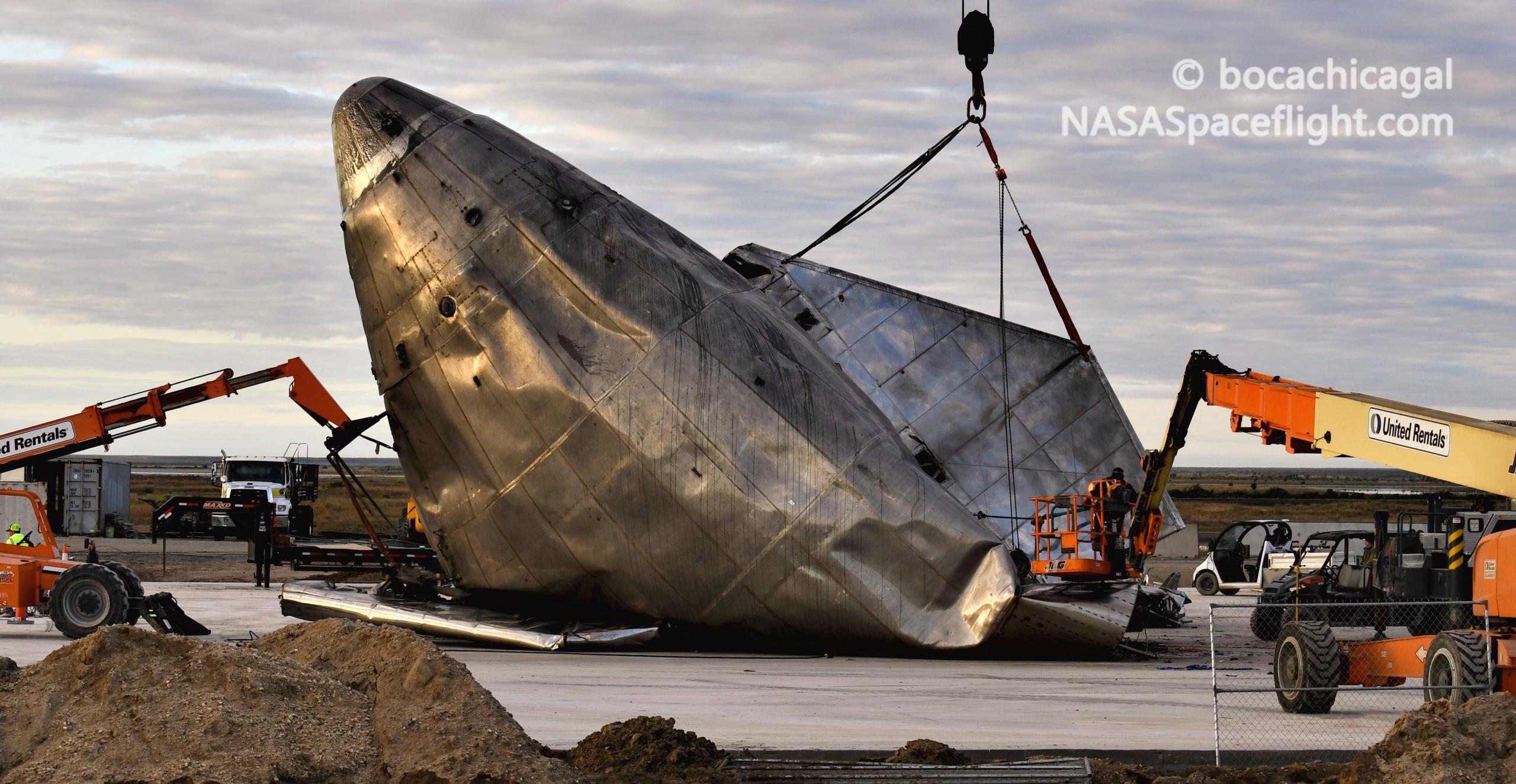
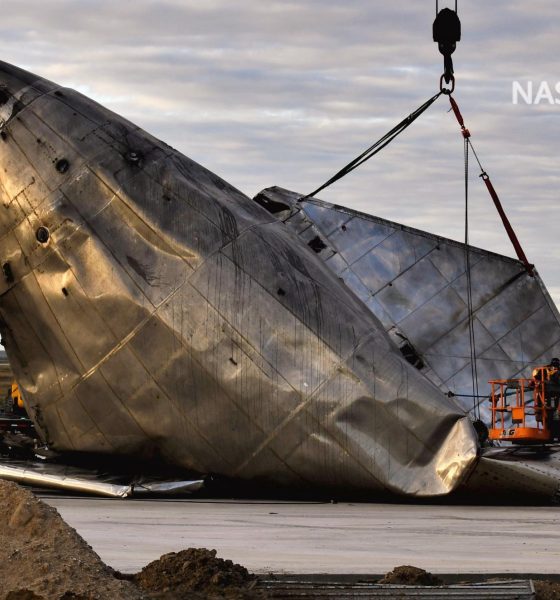
News
SpaceX scraps Starship SN8 wreckage, clears landing zone for next launch
In spite of tentative plans for preservation, SpaceX has fully scrapped the wreckage of the first high-altitude Starship prototype, clearing the landing zone it impacted for its successor’s imminent launch debut.
Known as serial number 8 or SN8, the Starship prototype was the first of any kind to fly beyond 150 meters (~500 ft), reaching an altitude of 12.5 km (~7.8 mi) on December 9th during its breathtaking launch debut. In an unexpected twist, SpaceX kept Starship SN8’s thrust to weight ratio as low as possible, stretching what could have been a two or three-minute test into an almost seven-minute ordeal with three consecutive Raptor engine cutoffs during the ascent.
At apogee, SN8 used cold gas thrusters to flip into a belly-down orientation and free-fell ~95% of the way back to Earth before igniting two of its three Raptor engines, performing a wild powered flip back into a vertical landing position and nearly securing a soft landing. Unfortunately, around 10-20 seconds before that planned landing, what Musk later described as low methane header tank pressure starved the Starship’s engines of fuel and more or less cut all appreciable thrust, causing SN8 to reach its landing zone traveling about 40 m/s (~90 mph) too fast. The rocket impacted the concrete pad, crumpled, and exploded.
By all accounts, success was one of the less likely outcomes SpaceX expected from SN8’s high-altitude debut, with Musk himself estimating the odds of total success to be just 33%. Additionally, Starship SN8 effectively made it all the way to a low-speed landing regime that Starships SN5 and SN6 all but flawlessly demonstrated with back-to-back 150m hops and landings in August and September 2020.
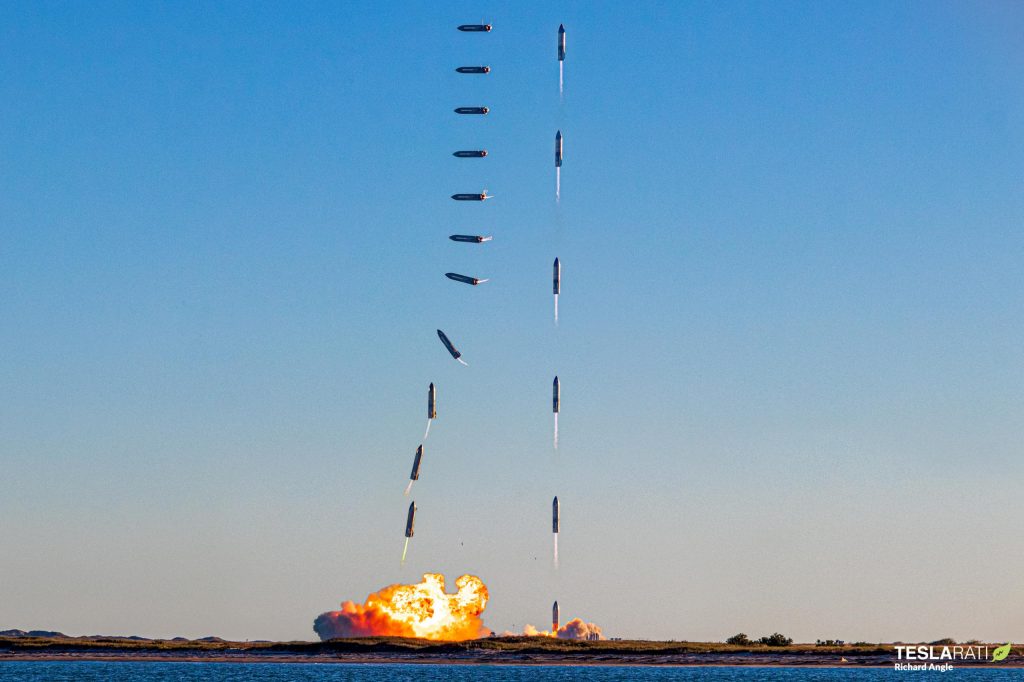
In other words, despite the explosive end, SN8’s high-altitude launch debut was a spectacular success for SpaceX’s Starship program – possibly even preferable to a perfect landing given that it uncovered an unexpected issue with fuel tank pressurization. Beyond the landing failure, the Starship checked every single box on SpaceX’s test flight list, successfully debuting multiple Raptors, demonstrating multiple in-flight engine shutdowns and engine relights; proving that an unprecedented ‘skydiver-style’ landing maneuver is possible and viable; and successfully testing Starship’s ability to control itself in that bellyflop orientation with thrusters and four massive flaps.
Speaking in a recent interview with Ars Technica, in the words of pragmatic SpaceX COO and President Gwynne Shotwell, SN8’s launch debut “de-risked [the Starship] program pretty massively.” According to Musk, SpaceX engineers were quickly able to determine why Starship SN8’s methane header tank was unable to maintain the fuel flow (pressure) needed for Raptor’s landing burn(s) and quickly implemented a solution.
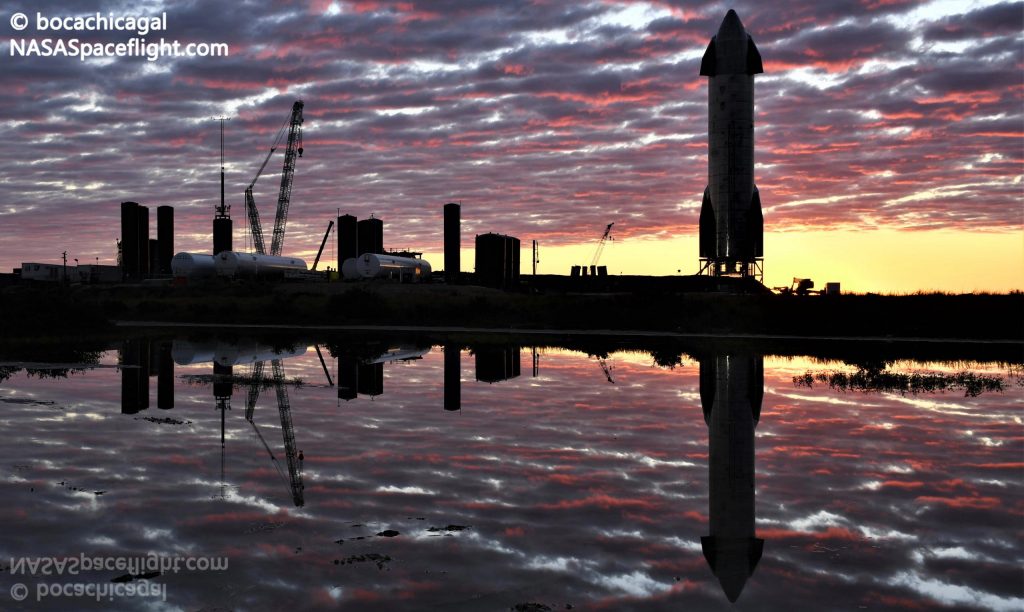
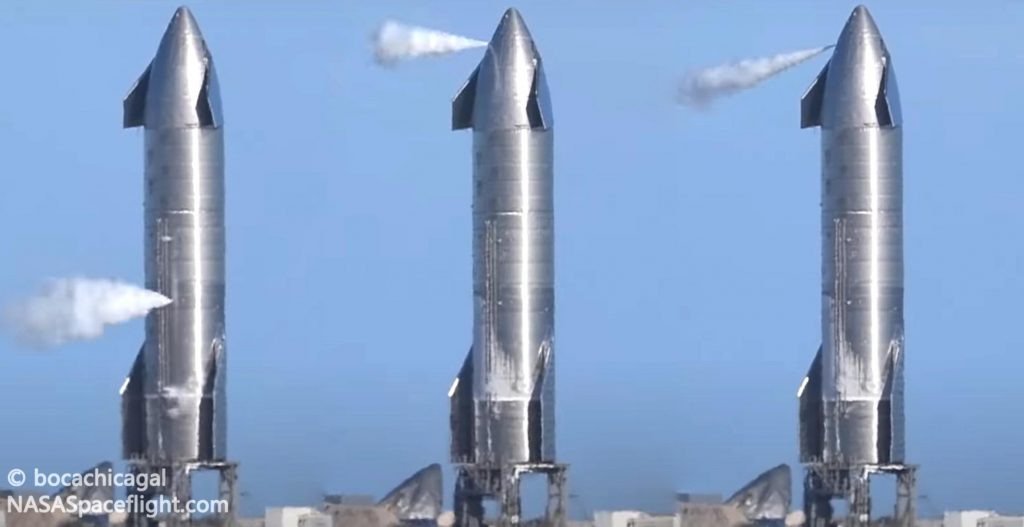
Instead of pressurizing autogenously with methane gas, Starship SN9 will use helium to pressurize its fuel header tank, serving as a temporary fix while SpaceX determines what changes need to be made to get rid of that helium crutch. Landing pad now cleared of Starship remains and SN8’s impact crater more or less repaired, the only thing standing between Starship SN9 and its own 12.5 km launch debut is a triple-Raptor static fire test. Originally expected as early as January 4th, SpaceX never made it more than a few minutes into the attempt, while a backup window on January 5th was canceled later that evening. The test could now occur no earlier than (NET) Wednesday, January 6th.


Thankfully, although SpaceX was unable to save the entirety of Starship SN8’s wrecked nose section, the company did manage to extract a largely intact nose flap. The rest of the remains were scrapped on site and trucked away but it’s possible that certain significant components of SN8 – particularly the recovered flap – will eventually find themselves on display at one or more SpaceX facilities.

News
Tesla aims to combat common Full Self-Driving problem with new patent
Tesla writes in the patent that its autonomous and semi-autonomous vehicles are heavily reliant on camera systems to navigate and interact with their environment.

Tesla is aiming to combat a common Full Self-Driving problem with a new patent.
One issue with Tesla’s vision-based approach is that sunlight glare can become a troublesome element of everyday travel. Full Self-Driving is certainly an amazing technology, but there are still things Tesla is aiming to figure out with its development.
Unfortunately, it is extremely difficult to get around this issue, and even humans need ways to combat it when they’re driving, as we commonly use sunglasses or sun visors to give us better visibility.
Cameras obviously do not have these ways to fight sunglare, but a new patent Tesla recently had published aims to fight this through a “glare shield.”
Tesla writes in the patent that its autonomous and semi-autonomous vehicles are heavily reliant on camera systems to navigate and interact with their environment.

The ability to see surroundings is crucial for accurate performance, and glare is one element of interference that has yet to be confronted.
Tesla described the patent, which will utilize “a textured surface composed of an array of micro-cones, or cone-shaped formations, which serve to scatter incident light in various directions, thereby reducing glare and improving camera vision.”

The patent was first spotted by Not a Tesla App.
The design of the micro-cones is the first element of the puzzle to fight the excess glare. The patent says they are “optimized in size, angle, and orientation to minimize Total Hemispherical Reflectance (THR) and reflection penalty, enhancing the camera’s ability to accurately interpret visual data.”
Additionally, there is an electromechanical system for dynamic orientation adjustment, which will allow the micro-cones to move based on the angle of external light sources.
This is not the only thing Tesla is mulling to resolve issues with sunlight glare, as it has also worked on two other ways to combat the problem. One thing the company has discussed is a direct photon count.
CEO Elon Musk said during the Q2 Earnings Call:
“We use an approach which is direct photon count. When you see a processed image, so the image that goes from the sort of photon counter — the silicon photon counter — that then goes through a digital signal processor or image signal processor, that’s normally what happens. And then the image that you see looks all washed out, because if you point the camera at the sun, the post-processing of the photon counting washes things out.”
Future Hardware iterations, like Hardware 5 and Hardware 6, could also integrate better solutions for the sunglare issue, such as neutral density filters or heated lenses, aiming to solve glare more effectively.
Elon Musk
Delaware Supreme Court reinstates Elon Musk’s 2018 Tesla CEO pay package
The unanimous decision criticized the prior total rescission as “improper and inequitable,” arguing that it left Musk uncompensated for six years of transformative leadership at Tesla.

The Delaware Supreme Court has overturned a lower court ruling, reinstating Elon Musk’s 2018 compensation package originally valued at $56 billion but now worth approximately $139 billion due to Tesla’s soaring stock price.
The unanimous decision criticized the prior total rescission as “improper and inequitable,” arguing that it left Musk uncompensated for six years of transformative leadership at Tesla. Musk quickly celebrated the outcome on X, stating that he felt “vindicated.” He also shared his gratitude to TSLA shareholders.
Delaware Supreme Court makes a decision
In a 49-page ruling Friday, the Delaware Supreme Court reversed Chancellor Kathaleen McCormick’s 2024 decision that voided the 2018 package over alleged board conflicts and inadequate shareholder disclosures. The high court acknowledged varying views on liability but agreed rescission was excessive, stating it “leaves Musk uncompensated for his time and efforts over a period of six years.”
The 2018 plan granted Musk options on about 304 million shares upon hitting aggressive milestones, all of which were achieved ahead of time. Shareholders overwhelmingly approved it initially in 2018 and ratified it once again in 2024 after the Delaware lower court struck it down. The case against Musk’s 2018 pay package was filed by plaintiff Richard Tornetta, who held just nine shares when the compensation plan was approved.
A hard-fought victory
As noted in a Reuters report, Tesla’s win avoids a potential $26 billion earnings hit from replacing the award at current prices. Tesla, now Texas-incorporated, had hedged with interim plans, including a November 2025 shareholder-approved package potentially worth $878 billion tied to Robotaxi and Optimus goals and other extremely aggressive operational milestones.
The saga surrounding Elon Musk’s 2018 pay package ultimately damaged Delaware’s corporate appeal, prompting a number of high-profile firms, such as Dropbox, Roblox, Trade Desk, and Coinbase, to follow Tesla’s exodus out of the state. What added more fuel to the issue was the fact that Tornetta’s legal team, following the lower court’s 2024 decision, demanded a fee request of more than $5.1 billion worth of TSLA stock, which was equal to an hourly rate of over $200,000.
Delaware Supreme Court Elon Musk 2018 Pay Package by Simon Alvarez
News
Tesla Cybercab tests are going on overdrive with production-ready units
Tesla is ramping its real-world tests of the Cybercab, with multiple sightings of the vehicle being reported across social media this week.

Tesla is ramping its real-world tests of the Cybercab, with multiple sightings of the autonomous two-seater being reported across social media this week. Based on videos of the vehicle that have been shared online, it appears that Cybercab tests are underway across multiple states.
Recent Cybercab sightings
Reports of Cybercab tests have ramped this week, with a vehicle that looked like a production-ready prototype being spotted at Apple’s Visitor Center in California. The vehicle in this sighting was interesting as it was equipped with a steering wheel. The vehicle also featured some changes to the design of its brake lights.
The Cybercab was also filmed testing at the Fremont factory’s test track, which also seemed to involve a vehicle that looked production-ready. This also seemed to be the case for a Cybercab that was spotted in Austin, Texas, which happened to be undergoing real-world tests. Overall, these sightings suggest that Cybercab testing is fully underway, and the vehicle is really moving towards production.
Production design all but finalized?
Recently, a near-production-ready Cybercab was showcased at Tesla’s Santana Row showroom in San Jose. The vehicle was equipped with frameless windows, dual windshield wipers, powered butterfly door struts, an extended front splitter, an updated lightbar, new wheel covers, and a license plate bracket. Interior updates include redesigned dash/door panels, refined seats with center cupholders, updated carpet, and what appeared to be improved legroom.
There seems to be a pretty good chance that the Cybercab’s design has been all but finalized, at least considering Elon Musk’s comments at the 2025 Annual Shareholder Meeting. During the event, Musk confirmed that the vehicle will enter production around April 2026, and its production targets will be quite ambitious.








